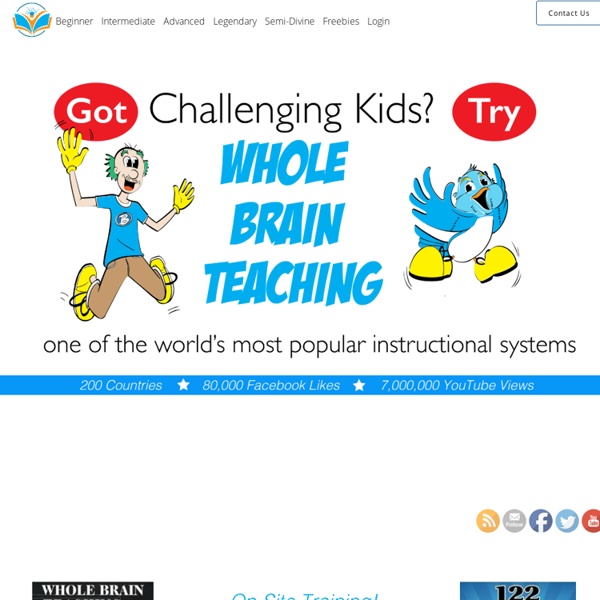



http://wholebrainteaching.com/
The Polka Dot Patch: Whole Brain Teaching Gestures, More Fun with Vinyl and TPT Sale!!! I have had a lot of requests for the gestures I use with my rules. I thought I had a document that lays it all out but of course I can't find it. The more I thought about it, the more I am thinking that I never had a document. I think I learned the gestures from watching the numerous Youtube videos about Whole Brain Teaching - Here is one of my favorites!! You will notice that my rules are a little bit different than the ones that are in the video. After using them for a few years a fellow teammate and I decided to tweak them just a little bit for this school year and see how it works.
Teaching Sixth Grade - A Good Year (much is applicable also to fifth grade and to fourth grade) Send me email - robert15115@gmail.com. Robert Jackson Information about Robert Jackson whole brain teaching Are you familiar with Whole Brain Teaching? I discovered it online last fall while I was exploring information on how the brain learns. This is the first video I saw on the topic: You may notice in the video that the instructor (Coach B from WBT) keeps the students totally engaged, and uses many of the important brain based learning strategies: talking, using emotions, visuals, movement, teaching chunks of information, giving immediate feedback.
true story 3 little pigs Every year, no matter what grade I teach, I read the book, The True Story of the 3 Little Pigs. I always read this story the first week of school for two reasons. First of all, it is my favorite story which I tell my class. This builds a personal connection with my students. I have found this book is a wonderful resource for conflict management.
Journal of Physiology-Paris : The slow process: A hypothetical cognitive adaptation for distributed cognitive networks Volume 101, Issues 4–6, July–November 2007, Pages 214–222 The Evolution of Human Cognition and Neuroscience: a Dialogue between Scientists and Humanists Edited By Alan Smith, Yves Frégnac and Kirsty Grant Abstract Human cognitive evolution is characterized by two special features that are truly novel in the primate line. The first is the emergence of “mindsharing” cultures that perform cooperative cognitive work, and serve as distributed cognitive networks.
Substitute Teaching: Tips, Tricks, Ideas, Suggestions, and Methods for Substitute Teachers Have a collection of tests/quizzes in your packet. Here are Internet addresses of some tests/quizzes, found by doing a search in the Internet for "test of knowledge" or "quiz": Challenge the class with a puzzler. ClipArt ETC Alphabets The Alphabets ClipArt collection offers 1,193 illustrations arranged in 43 galleries including decorative letters and numerals, complete alphabet sets, and several sign language systems. If you are looking… American History and Government
Tattle Tale Tips Have you ever had a class where you feel like they couldn't get along with their own shadow? In reality, it's only a handful of students who want to "report" every infraction, but it's exhausting when you get this group. I've found 2 different things that help combat tattling syndrome. Cooperative Learning Original module developed by Rebecca Teed, John McDaris, and Cary Roseth Enhanced by KimMarie McGoldrick with assistance from Jim Cooper, Dan Marburger, Jennifer Rhoads, Karl Smith What is Cooperative Learning? Cooperative Learning involves structuring classes around small groups that work together in such a way that each group member's success is dependent on the group's success. There are different kinds of groups for different situations, but they all balance some key elements that distinguish cooperative learning from competitive or individualistic learning. Cooperative learning can also be contrasted with what it is not.
Successful Learning - Designing Learning Environments An efficient way to accomplish this challenging task is to determine common learning-difference profiles and match individualized solutions to audiences differentiated by these profiles. This is actually simpler than it seems. Research helps us broadly describe four learning orientation profiles. Below are descriptions for mass customized learning environments that fit each of the learning orientations: Transforming Learners prefer loosely structured, flexible mentoring environments that promote challenging goals, discovery, strategies, problem solving, and self-managed learning. Performing Learners prefer semi-structured environments that stimulate personal value and provide details, tasks, processes, and creative interaction (hands-on) not exploration and great effort.
Twenty Tidbits for New Teachers In no way, do I want to add to the burden of the already-filled-to-the-brim, new teacher stress bucket. I do however, want to share just 20 tidbits which I hope will help ease new teachers into a fun, successful school year. Some of these will be in the form of social media tools, which I think are awesome, and wish I had had as a newbie.
How to Restore a Whiteboard with Step-by-Step Pictures Edit Article Edited by Benn, Flickety, Lillian May, Blizzerand and 9 others Don't throw old whiteboards away. This article describes how to restore dry erase whiteboards that become hard to erase and/or require constant cleaning. weekly chart for clip chart I had read on Jodi's blog The Clutter-free Classroom that one of the best things she had ever done in her classroom was start a behavior clip chart. Well let me quote her BEST. THING. EVER.